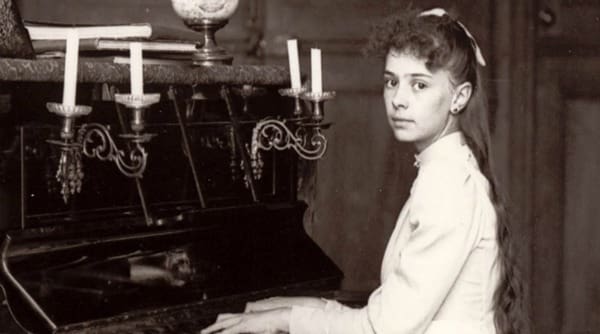Today, November 8, we celebrate the feast day of St. Elizabeth of the Trinity, a French Carmelite considered by Pope St. John Paul II to be one of the most influential mystics of his life.
St. Elizabeth of the Trinity was born as Elizabeth Catez, “Sabeth” to her friends, in 1880. She was a hot-tempered child with sometimes “furious eyes” whose father died while she was young, forcing her mother to move Sabeth and her younger sister from their home in Dijon to a smaller second-story flat. From her window, little Sabeth could look down into the garden of the Carmelite convent.
Slowly, a desire to give herself completely to Jesus, whom she encountered profoundly in the Eucharist, began to take shape. Carmel called to her. And although she would become an accomplished pianist, travel extensively, and have many friends and multiple offers of marriage, Sabeth chose to leave it all behind at the door of the convent.
Given the name Elizabeth of the Trinity, she would live only five years after her entrance to Carmel. She would leave, however, like her close contemporary St. Thérèse of Lisieux, a rich spiritual legacy of writings and reflections weighted with depth and profound theology, while buoyant with joy and love. In contrast to the Jansenism which pervaded France at the time and portrayed God as primarily a Just Judge, she foreshadowed the message of St. Faustina and encountered Him as an “Abyss of Mercy.” In the deepest part of her, in her own personal poverty, her “abyss of nothingness” collided with this merciful expanse of endless love.
This Abyss of Love was not a nameless void, but a Somebody. A living reality. A Trinity of Persons, boundless and yet intimate and near and able to be known and loved.
Elizabeth lived her life with constant awareness of the life of the Trinity within her. In the center of her soul, the “secret cellar,” she found a bottomless depth of the divine. She knew that there she could taste heaven even while on earth, that our heaven – which, in the end, is union with God – began even now, a sort of present paradise. She saw her life as an “anticipated heaven” and time as “eternity begun and still in progress.” She lived under and in the constant gaze of her beloved, who had put the timeless into her heart (Eccl 3: 11), and felt herself plunged in a love so immense and unfathomable she could not help but praise Him, and not just praise Him, but become a song of praise herself, dissolved into Him.
The first work I read of Elizabeth’s was a retreat she wrote entitled “Heaven in Faith.” A series of twenty prayerful meditations, to be read over ten days, it encapsulated her mystical, luminous heart. Spilling over with love and longing, it is a true testament of praise to the glory of God.
All of which, perhaps, seems fitting for a little saint in a monastery. Surely the nuns benefitted from her pious reflections, we think, as we shuffle bills and babies. Too bad those of us called to remain in the world cannot remain as recollected, cannot experience such interior solitude and boundless grace. If only we could crawl into a convent for a while and find God.
But here’s the beautiful thing. Elizabeth wrote “Heaven in Faith” not for the nuns, but for her sister, Guite, who at the time was a young mother at home with two small children (one of whom would follow her aunt into the convent). Eventually, Guite would raise a total of nine children. In other words, Elizabeth didn’t see the business of a mom as an excuse not to go into the depths of contemplative prayer right where she was in her home, in the midst of her own vocation. Instead, she urges all of us not to neglect the depths of our heart, however dusty it may be. Someone, she knows, waits for us there. And she doesn’t want us to wait any longer to find Him in the deepest part of ourselves and abide with Him there, in the interior quiet we can create through prayer, even in the midst of chaos. In other words, holiness, which is really just extraordinary love, the flowering of baptism grace, is for anyone. It is, in fact, for everyone.
No one has to hover on the outside of the Lord’s love, no matter how busy and noisy life is, no matter how every clamorous thing seems to push us further away from Him. No. Even in the chaos, there is a deeper silence that breathes peace – not a mere emptiness, not an absence, but a Someone whose love is immense and deafening.
We can all live as contemplatives in our approach to life. To abide with Him under “our roof” however unworthy we feel. To keep company with Christ in the cell of our hearts even while in the noise of our homes. To be Marthas who linger interiorly at the feet of Jesus, or even more, in His arms. To allow His presence to saturate every area of life and sanctify and make sacramental the groceries, the laundry, the freeway. “Each incident,” Elizabeth explained, ” each event, each suffering, as well as each joy, is a sacrament which God gives to (the soul); so it no longer makes a distinction between these things; it surmounts them, goes beyond them to rest in its Master, above all things.”
“She understood it to be her apostolate to infect as many as possible with an immense longing for the infinite,” said Hans Urs Von Balthasar in Two Sisters in the Spirit. Once our souls become containers for infinity, it simply will spill over and satisfy the thirst of others, too.
I think in this way, even while enclosed in Carmel, even from her little cells, both exterior and interior, she contributes to the sanctification of the laity.
Just eleven days before her death from Addison’s disease, twenty-six-year-old Elizabeth wrote:
“I think that in Heaven my mission will be to draw souls by helping them to go out of themselves in order to cling to God by a wholly simple and loving movement and to keep them in this great silence within which will allow God to communicate Himself to them and to transform them into Himself.”
Two days later, her family would gather around her, expecting to say goodbye. Instead, she would suffer a novena of agony before entering Heaven nine days later on November 9, 1906. She was just twenty-six. The heaven she began on earth would finally reach its limitless end.
Unlike St. Thérèse, Elizabeth saw her mission in heaven to be hidden and interior. But the Church has wisely lifted the bushel, so to speak, that we can all call on her friendship and prayers for us as we venture to find the Trinity deep within. May her light help lead the way.
____________________________________________________________________
For more on St. Elizabeth and the Indwelling of the Trinity, see This Present Paradise: A Spiritual Journey with St. Elizabeth of the Trinity by Claire Dwyer.
Image credit, Wikimedia Commons





